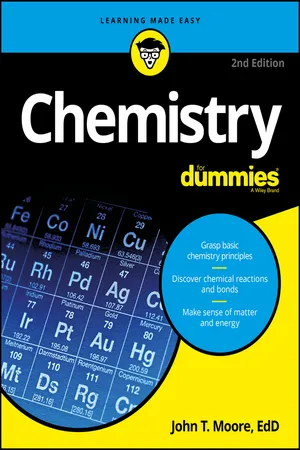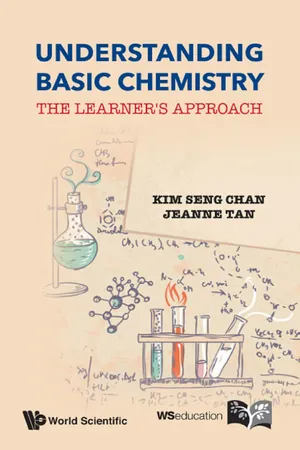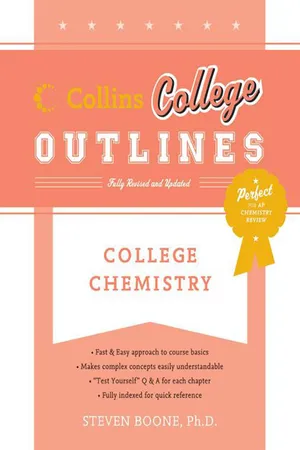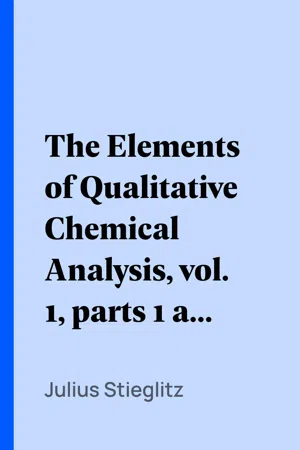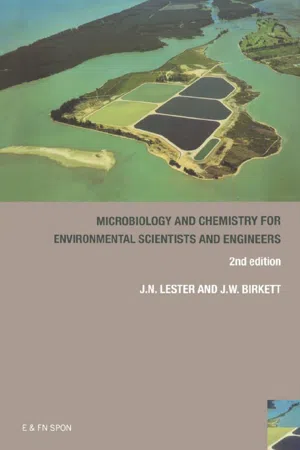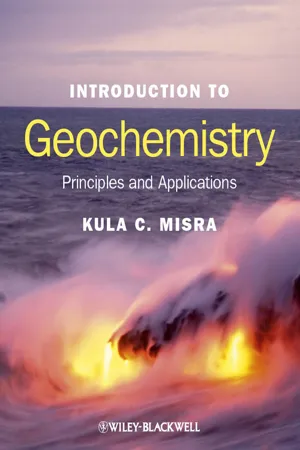Chemistry
Ions: Anions and Cations
Ions are charged particles formed when atoms gain or lose electrons. Anions are negatively charged ions formed when an atom gains electrons, while cations are positively charged ions formed when an atom loses electrons. These charged ions play a crucial role in chemical reactions and the behavior of substances in various environments.
Written by Perlego with AI-assistance
Related key terms
Related key terms
1 of 4
Related key terms
1 of 3
9 Key excerpts on "Ions: Anions and Cations"
- eBook - ePub
- John T. Moore(Author)
- 2016(Publication Date)
- For Dummies(Publisher)
+ represents its net positive electrical charge).This unequal number of negative and positive charges can occur in one of two ways: An atom can gain a proton (a positive charge) or lose an electron (a negative charge). So which process is more likely to occur? Well, the rough guideline is that gaining or losing electrons is easy but gaining or losing protons is very difficult. So atoms become ions by gaining or losing electrons.If an ion is formed by the loss of an electron, the ion has more protons than electrons, or more positive charges. Those positive ions are called cations. You represent the overall positive charge in cations with the little plus sign in the notation (like Na+ ). If the atom loses two electrons instead of one, the result is still a cation, but it has a stronger positive charge (actually twice as strong as in the case in which only one electron was lost) and is represented with the number of electrons lost and a plus sign (like Mg2+ for a magnesium cation with two missing electrons, or Al3+ for aluminum with three electrons gone).If an ion is created by gaining an electron, the number of electrons exceeds the number of protons, so the ion acquires a negative charge. Negatively charged ions are called anions, and they’re represented with a little negative sign (– ). If chlorine (Cl) gains an electron, it becomes a chlorine ion because it has unequal numbers of protons and electrons, and as an anion (a negatively charged ion), it’s represented as Cl– . (You can get the full scoop on ions, cations, and anions in Chapter 13 , if you’re interested. This here’s just a teaser.)Just for kicks, here are some extra tidbits about ions for your reading pleasure:- You can write electron configurations and energy-level diagrams for ions. The neutral sodium atom (11 protons) has an electron configuration of 1s2 2s2 2p6 3s1 . The sodium cation has lost an electron — the valence electron, which is farthest away from the nucleus (the 3s electron, in this case). The electron configuration of Na+ is 1s2 2s2 2p6
- eBook - ePub
Understanding Basic Chemistry
The Learner's Approach
- Kim Seng Chan, Jeanne Tan(Authors)
- 2014(Publication Date)
- WSPC(Publisher)
net electrostatic attractive force that exists, and this net electrostatic attractive force is the ionic bond that holds the two particles together. So for simplicity, we just say that a cation attracts an anion.QHow do we determine the number of electrons to be gained or lost in forming ionic compounds?A:We make use of the octet rule.3.2.2 The octet ruleThe octet rule is an observational conclusion that states, “atoms tend to lose, gain, or share electrons until they are surrounded by eight valence electrons.” The octet rule stems from the fact that all noble gases (except helium) have eight valence electrons. They have very stable electronic arrangements, as evidenced by their high ionization energy, low affinity for additional electrons, and general lack of reactivity.However, one must take note that there are many exceptions to the octet rule which we will see in later sections. The octet rule should not be used as a driving force to explain why ionic compounds are formed! Instead, it should be just a guideline to help us decide how many electrons are to be lost, gained or shared, BUT NOT the reason for why electrons are being lost, gained, or shared. Bear this clearly in mind!Apart from transition metals (d-block), Group I to III metals will lose the number of electrons corresponding to their group number, which represents the number of valence electrons. The non-metals (Groups V, VI, and VII) will tend to gain the required number of electrons to make up a total of eight electrons in the valence shell.QWhat is the meaning of the term “valence?”A:The combining capacity of an element is called its valency. The term “valence” is the number of electrons gained, lost, or shared to attain the stable octet configuration. For example, sodium has configuration (2.8.1) and tends to gain the stable octet configuration of neon, Ne (2.8), by losing an electron. Hence, its valency is +1. The “+” sign indicates the loss of electron. The chlorine atom (2.8.7) commonly forms the chloride ion (2.8.8), Cl− , with a valency of −1. The “−” sign means gain of an electron. The valency of chlorine can go to a maximum of 7 (refer to Chapter 12 - eBook - ePub
- Jeffrey Gaffney, Nancy Marley(Authors)
- 2017(Publication Date)
- Elsevier(Publisher)
Chapter 3Chemical Bonding—The Formation of Materials
Abstract
This chapter covers chemical bonding between atoms and ions and how this affects the chemical properties of the elements. Which elements form ions and the typical charges on the ions are explained. Ionic bonding and covalent bonding are compared in terms of the octet rule and valence bond theory. Polar and nonpolar covalent bonds are explained and their relationship to both electron group geometry and molecular geometry is stressed. Polyatomic ions are described as a mixed ionic, covalent species. Molecular orbital theory is introduced to explain magnetism, bond order, and hybridization, which will be important in later discussions of the chemistry of carbon. Intermolecular forces, including hydrogen bonding, are discussed with a special Case Study focusing on the special properties of water.Keywords
Ionic bonding; Covalent bonding; Octet rule; Polyatomic ions; Dipole moment; Molecular orbitals; Hybridization; Resonance; Molecular geometry; Intermolecular forcesOutline3.1Atoms and Ions3.2Ionic Bonding3.3Covalent Bonding3.4Mixed Covalent/Ionic Bonding3.5Molecular Orbitals3.6Molecular Geometry3.7Molecular Polarity3.8Intermolecular ForcesImportant TermsStudy QuestionsProblems3.1 Atoms and Ions
A neutral atom that loses one or more electrons becomes a positively charged ion. This positively charged ion is known as a cation (from the Greek word katá , meaning “down”). A neutral atom that gains one or more electrons has a negative charge and is known as an anion (from the Greek word ánō , meaning “up”). The number of electrons an element will gain or lose is also a periodic property and can generally be predicted from its position in the periodic table as shown in Fig. 3.1 . Atoms will gain or lose electrons to form ions that have electronic configurations which are more stable than the electronic configurations of the parent atoms. For most elements, this means that they will either gain or lose the number of electrons needed to achieve a closed valence shell. Remember from Table 2.9 of Chapter 2 - eBook - ePub
Inorganic Chemistry
From Periodic Classification to Crystals
- Robert Valls(Author)
- 2017(Publication Date)
- Wiley-ISTE(Publisher)
NOTE 1.8.– The description of ions depends on the type of ions in question. There are ions in solution, in solids, in vacuum, in reactions, etc. The existence of ions is connected to their environment.Let us consider the example of the O2– anion in CaO, which in solution yields OH– and does not remain in the form of an anion with 2 charges (the oxide is said to be basic).The H+ ion exists in stars or in the Earth’s ionosphere but when in solution it is referred to as H3O+, because it is associated with water molecules. NO2+ can be observed in the ionosphere or in the vacuum of a spectrometer, but it is NO2– that is more stable and NO3– that is the most common. The S+IV cation, which is virtual, for example, in the form of sulfate ions either in solution or in solids or atypical ions such as a compound of copper IV in ions such as CuF62–. The CH3+, OH+ or CN+ ions are also formed in mass spectrometers, the NO2+, Br+, C2H7+ ions are reaction intermediates and H3+, CH2+, HCO+ ions are present in space.From a chemist’s perspective, ions are present in solution; but in this case, the size is not an essential criterion; on the contrary, the ions mentioned in Figure 1.31 relate to solids in which size plays a very important role.1.4.2. Radius of ions through the classification
If ionic radii are observed by means of the classification, it can be noted that radii increase within one family, for example that of alkaline or halogen elements. Within one period, for example from Na+ to Al3+ , the size of ions decreases while the charge increases, in the case of metals.It is difficult to visualize the notion of periodicity, and the evolution of ionic radii is perceived as complex.Several simple rules can be stated; for cations, the ionic radius is smaller than the atomic radius and it decreases when the charge increases. When the atom loses electrons, the attraction of protons in the nucleus induces compression of electron shells.Figure 1.31 . Size of (six-coordinate) ions in the classification. For a color version of this figure, see www.iste.co.uk/valls/inorganic.zip - No longer available |Learn more
- Steven Boone, Drew H. Wolfe(Authors)
- 2011(Publication Date)
- Collins Reference(Publisher)
CHAPTER 10Chemical Bonding: Fundamental Concepts
A chemical bond is the force of attraction that one atom (or ion) has for another atom (or ion). The principal driving force for atoms to combine and form molecules is the release of energy by atoms as they stabilize through bonding. The two principal types of bonds discussed in this chapter are ionic and covalent bonds.10.1 INTRODUCTION TO CHEMICAL BONDINGChemical bonds are the forces that hold atoms together when compounds are formed. Ionic or Electrovalent BondsIonic bonds most commonly result when one or more electrons transfer from a metal to a nonmetal. When this occurs, the metal atom becomes a cation, and the nonmetal atom becomes an anion. Ionic bonds are the electrostatic forces of attraction among the resulting positive and negative ions.Covalent BondsA covalent bond results when the orbitals of two nonmetal atoms overlap and the nuclei of the atoms attract the electrons in the overlapping region. This is called electron sharing .Bonding TheoriesThe valence bond and molecular orbital theories are most often used to explain the properties and formation of chemical bonds. The Valence Bond Theory primarily considers the interactions of the electrons in the outer shell (valence electrons) in the formation of bonds. The Molecular Orbital Theory considers the energies of all the electrons in the atoms that form chemical bonds. Scientists use both theories to explain chemical bonds and molecular structures, because neither can explain adequately the bonds in all chemical species.Lewis Symbols and Lewis FormulasThe valence electron configurations of the atoms are often shown using Lewis symbols and Lewis structures. To write the Lewis symbol of an atom, place as many dots around its symbol as there are valence electrons. For example, one way to write the Lewis symbol of N is shown in Figure 10.1. Five dots are placed around the symbol of nitrogen because it has five valence electrons, 2s2 2p3 - eBook - ePub
The Elements of Qualitative Chemical Analysis, vol. 1, parts 1 and 2.
With Special Consideration of the Application of the Laws of Equilibrium and of the Modern Theories of Solution.
- Julius Stieglitz(Author)
- 2014(Publication Date)
- Perlego(Publisher)
The Theory of Ionization and the Electron Theory of Electricity and of Matter.
66 —According to the views held by many leading physicists at the present time, negative electricity consists of ultimate particles of matter called electrons or corpuscles. The mass of an electron is about 1 / 1000 the mass of an atom of hydrogen, and the electric charge of the electron is equal to that carried by a chloride ion in solution.67 The atoms of the elements are considered to consist of aggregations of large numbers of electrons in a kind of "shell" or "body" of positive electricity. This positive electricity, in a given atom, is equal in quantity to the total negative charge of the electrons in the atom, the atoms as such [p043] containing no excess of either positive or negative electricity. The number of electrons in the atom of an element is considered to be definite and constant for that element, but the number varies as we go from the atoms of one element to those of a second element, the number increasing with the atomic weight of the element.One of the most fundamental and most characteristic properties of elements is considered to be the affinity which their atoms show for electrons ; thus, the atoms of metals like sodium and potassium, which are generally called "electropositive" elements,68 show an enormous tendency to lose one electron each and to form positively charged particles69Na-ε(= Na+ )and K-ε (= K+ ).70 The atoms of strongly electronegative elements, like chlorine, have a tremendous tendency for gaining and holding electrons beyond the number originally in such atoms. Thus, chlorine atoms tend to assume an electron each; they thereby become negatively charged particles,Cl+ε( = Cl− ).On the basis of these views, we have in sodium chloride NaCl a substance, whose molecules contain an atom, Na, with a tremendous tendency to lose an electron , and an atom, Cl, which has a tremendous affinity for an electron . It is natural to suppose, then, that both tendencies will be satisfied by the passage of an electron from the sodium to the chlorine atom , NaCl → Na-ε Cl+ε . Or, if we use the sign + to designate the positive charge produced on an atom by the loss of an electron and the sign − to indicate the charge gained through the assumption of an electron, we have71 : NaCl isNa+ Cl− .Similarly we have in hydrogen chlorideH-ε Cl+εorH+ Cl− .It is altogether likely, therefore, that the atoms in a molecule of sodium chloride or of hydrogen chloride already possess electric charges,72 so that, even while combined, [p044] their tendencies to lose or gain electrons are satisfied. It is also possible that the atoms are held together in the molecule by the electrical attraction of the opposite charges.73 The force with which opposite electrical charges attract each other depends, as is well known, on the nature of the surrounding medium . Now, when molecular sodium chloride or hydrogen chloride is dissolved in water (a favorable medium), a decided decrease in the attraction (see p. 62 ), between the charged atoms within the molecules is brought about, and a process of ionization results:H+ Cl− ⇄ H+ + Cl− - Jason Birkett, John Lester(Authors)
- 2018(Publication Date)
- CRC Press(Publisher)
Chapter 6Introduction to chemistry
6.1 Introduction
Chemistry can be defined as the study and elucidation of the structure and properties of matter. All chemists are taught the fundamental principles of chemistry, a science which has concepts that are also important in environmental engineering. This chapter reviews basic chemical concepts that are related to the branch of inorganic chemistry.6.2 The atom
Regarding the actual nature of matter, two hypotheses were put forward. One stated that matter is a structure that is infinitely divisible. The other stated that matter is comprised of discrete particles called atoms. This theory was supported by John Dalton, who believed that atoms were the solid building blocks of matter. Subsequent work by Rutherford and other scientists proved that the atom had electrical sub-particles and was in fact divisible.The atom is considered to comprise the following sub-particles:- The nucleus which contains protons and neutrons. Protons have a charge of +1 and a mass of 1; neutrons have zero charge and a mass of 1. Particles present in the nucleus can also be termed collectively as nucleons.
- Electrons which have a charge of -1 and a mass of 1/1836 of a proton. These negative particles can be considered as particles orbiting the nucleus on a given path, or as clouds of electrical charge surrounding the nucleus. The latter is thought to be more probable due to Heisenberg’s uncertainty principle, which places a limit on the accuracy with which the position and motion of a particle may be calculated. This uncertainty is large for electrons.
6.2.1 Atomic number and mass
The atomic number (usually given the symbol Z) represents the number of protons present in the nucleus. In a neutral atom, this also corresponds to the number of electrons in the element.The atomic mass number is the number of protons plus the number of neutrons in the nucleus, and is given by the symbol A. Thus, the number of neutrons can be given by A—Z. An element can therefore be defined as a substance consisting of atoms with the same atomic number. This does not apply to the atomic mass. Neutrons present in the nucleus do not affect the atomic number or the chemical reactivity of that element. However, with a mass of 1, the number of neutrons present in the nucleus will affect the mass of the atom. Chemically identical atoms that have different numbers of neutrons are termed isotopes. The simplest isotopes are those of hydrogen and are shown in Fig. 6.1- eBook - ePub
Chemistry as a Game of Molecular Construction
The Bond-Click Way
- Sason Shaik(Author)
- 2016(Publication Date)
- Wiley(Publisher)
7A will form ionic bonds (see Lecture 9).Scheme 8.2The common cation and anion constituents of ionic bonds are the metals of groups 1A 3A, which form cations, and the late nonmetals of groups 5A 7A, which form anions. Transition metals also form cations.The classical example of an ionic bond is Na+ Cl− . Figure 8.2 shows pictorially the formation of Na+ Cl− from its elements. Na is a metal, which is a grayish solid, usually kept under kerosene oil because the metal goes wild if exposed to humidity or to oxygen, bringing about vigorous reactions, heat and fire. Chlorine, Cl2 , is a yellow-greenish gas, which is extremely toxic, and it was used in World War I as a chemical weapon. On the other hand, it can be used as a water disinfectant and hence a “provider” of life-giving water. So the gas chlorine is another manifestation of the chemical Janus. But I am digressing. Getting back to our reaction in Figure 8.2 , we can see that as a grayish metal and a green gas meet, lo and behold, they both disappear and give rise to the neat-looking white crystals of the salt Na+ Cl− , which we can taste and use in our food. This is the chemical magic at its best: two materials disappear and a new one, a completely different one, appears instead.Figure 8.2The chemical “magic”: formation of the salt Na+ Cl− (table salt) from a grayish metal (Na) and a yellow-greenish gas (Cl2 ). These photographs were obtained from http://en.wikipedia.org/wiki/File:Na_%28Sodium%29.jpg , http://commons.wikimedia.org/wiki/File:Chlorine2.jpg (public domain image), and http://en.wikipedia.org/wiki/File:Salt_shaker_on_white_background.jpg - eBook - ePub
Introduction to Geochemistry
Principles and Applications
- Kula C. Misra(Author)
- 2012(Publication Date)
- Wiley-Blackwell(Publisher)
Fig. 2.8 ).2.4 Chemical behavior of elements
The chemical behavior of an element is governed by its electronic configuration because the energy level of the atom is determined by the spatial distribution of its electron cloud. It is only the most loosely bound electrons in the outermost orbitals that take part in chemical interaction with other atoms. For example, the alkali elements (group IA of the Periodic Table), all of which have one electron in the outermost orbital, exhibit similar chemical properties; so do the alkaline earth metals (group IIA of the Periodic Table), all of which have two electrons in the outermost orbital.2.4.1 Ionization potential and electron affinity
Two concepts are useful in predicting the chemical behavior of elements: ionization potential (or ionization energy) ; and electron affinity . Ions are produced by the removal of electron(s) from or the addition of electron(s) to a neutral atom. The energy that must be supplied to a neutral atom (M) in the gas phase to remove an electron to an infinite distance is called the ionization potential (I) . In other words, the ionization potential is the difference in potential between the initial state, in which the electron is bound, and the final state, in which it is at rest at infinity; the lower the ionization potential, the easier it is to convert the atom into a cation. This is the reason why the ionization potential generally increases from left to right in a given period and from top to bottom within a given group of the Periodic Table (Fig. 2.9 ). The first ionization potential (I 1 ) refers to the energy required to remove the first (the least tightly bound) electron, the second ionization potential (I 2
Index pages curate the most relevant extracts from our library of academic textbooks. They’ve been created using an in-house natural language model (NLM), each adding context and meaning to key research topics.
Explore more topic indexes
Explore more topic indexes
1 of 6
Explore more topic indexes
1 of 4
